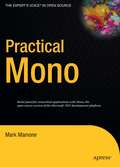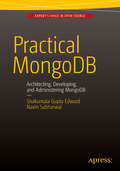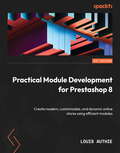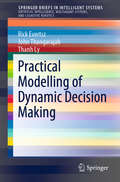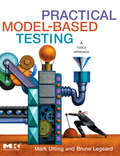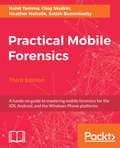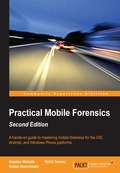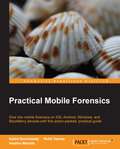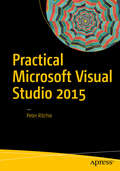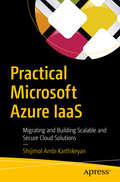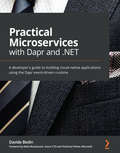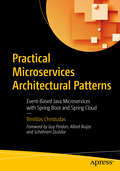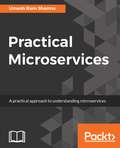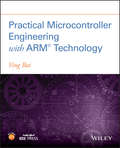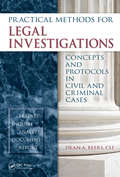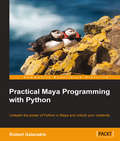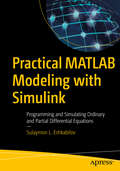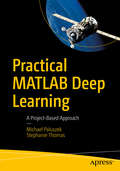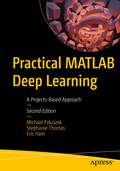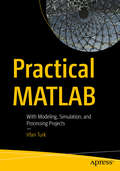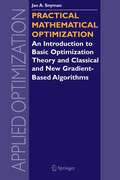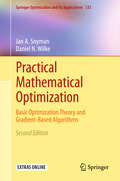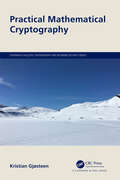- Table View
- List View
Practical Mono
by Mark Mamone* Authored by Mark Mamone who has been steeply involved with .NET since the first Beta release, this book introduces readers to Mono, the most prominent open source implementation of the .NET platform. It offers a C# primer, helping readers understand Mono by guiding them through the creation of an RSS aggregator. * The completed RSS aggregator will be available for download on sourceforge.net, the leading portal for open source project development. This will undoubtedly bring attention to the book. * Compliant for the forthcoming version 1.2
Practical MongoDB Aggregations: The official guide to developing optimal aggregation pipelines with MongoDB 7.0
by Paul DoneBegin your journey toward efficient data manipulation with this robust technical guide and enhance your aggregation skills while building efficient pipelines for a variety of tasksKey FeaturesBuild effective aggregation pipelines for increased productivity and performanceSolve common data manipulation and analysis problems with the help of practical examplesLearn essential strategies to aggregate time series data in financial datasets and IoTPurchase of the print or Kindle book includes a free PDF eBookBook DescriptionOfficially endorsed by MongoDB, Inc., Practical MongoDB Aggregations helps you unlock the full potential of the MongoDB aggregation framework, including the latest features of MongoDB 7.0. This book provides practical, easy-to-digest principles and approaches for increasing your effectiveness in developing aggregation pipelines, supported by examples for building pipelines to solve complex data manipulation and analytical tasks. This book is customized for developers, architects, data analysts, data engineers, and data scientists with some familiarity with the aggregation framework. It begins by explaining the framework's architecture and then shows you how to build pipelines optimized for productivity and scale. Given the critical role arrays play in MongoDB's document model, the book delves into best practices for optimally manipulating arrays. The latter part of the book equips you with examples to solve common data processing challenges so you can apply the lessons you've learned to practical situations. By the end of this MongoDB book, you’ll have learned how to utilize the MongoDB aggregation framework to streamline your data analysis and manipulation processes effectively.What you will learnDevelop dynamic aggregation pipelines tailored to changing business requirementsMaster essential techniques to optimize aggregation pipelines for rapid data processingAchieve optimal efficiency for applying aggregations to vast datasets with effective sharding strategiesEliminate the performance penalties of processing data externally by filtering, grouping, and calculating aggregated values directly within the databaseUse pipelines to help you secure your data access and distributionWho this book is forThis book is for intermediate-level developers, architects, analysts, engineers, and data scientists who are interested in learning about aggregation capabilities in MongoDB. Working knowledge of MongoDB is needed to get the most out of this book.
Practical MongoDB: Architecting, Developing, and Administering MongoDB
by Shakuntala Gupta Edward Navin SabharwalThe "one-size-fits-all" thinking regarding traditional RDBMSs has been challenged in the last few years by the emergence of diversified NoSQL databases. More than 120 NoSQL databases are now available in the market, and the market leader by far is MongoDB. With so many companies opting for MongoDB as their NoSQL database of choice, there's a need for a practical how-to combined with expert advice for getting the most out of the software. Beginning with a short introduction to the basics of NoSQL databases, MongoDB experts Navin Sabharwal and Shankatala Gupta Edward introduce readers to MongoDB – the leading document based NoSQL database, acquainting them step by step with all aspects of MongoDB. They cover the data model, underlying architecture, how to code using Mongo Shell, and administration of the MongoDB platform, among other topics. The book also provides clear guidelines and practical examples for architecting and developing applications using the MongoDB platform and deploying them. Database developers, architects, and database administrators will find useful information covering all aspects of the MongoDB platform and how to put it to use practically.Practical Guide to MongoDB provides readers with:A solid understanding of NoSQL databasesAn understanding of how to get started with MongoDBMethodical coverage of the architecture, development, and administration of MongoDBA plethora of "How to’s" enabling you to use the technology most efficiently to solve the problems you facePractical MongoDB is for those just starting to learning to work with NoSQL databases in general and MongoDB in particular. Skills in these areas are in demand, making this book essential reading for those who want to work more productively or break into big data work. It will prove equally useful for entrepreneurs and others who like to work with new technologies.
Practical Module Development for Prestashop 8: Create modern, customizable, and dynamic online stores using efficient modules
by Louis AUTHIEAfter version 1.7, PrestaShop underwent a host of changes, including migration to a Symfony-based system from an outdated legacy code. This migration brought about significant changes for developers, from routine maintenance to module development. Practical Module Development for PrestaShop 8 is curated to help you explore the system architecture, including migrated and non-migrated controllers, with a concise data structure overview. You’ll understand how hooks enable module customization and optimize the CMS. Through the creation of seven modules, you’ll learn about the structure of modules, hook registration, the creation of front-office controllers, and Symfony back-office controllers. By using Doctrine entities, services, CQRS, grids, and forms, you’ll be guided through the creation of standard, payment and carrier modules. Additionally, you'll customize and override themes to achieve your desired e-commerce store look. By the end of this book, you’ll be well equipped to provide modern solutions with PrestaShop that meet client requirements.Key FeaturesUnderstand the data and object architecture of the legacy and new Symfony core of PrestaShopCreate modules to add features such as content blocks, payment options, and carriers to your storeLearn to customize themes and override existing module templatesWhat you will learnUnderstand the structure of PrestaShop’s coreExplore hooks and their functionsCreate a hello world moduleBuild modules to display blocks in the front office with different stylesDesign a module to add fields to the category pages and manage themFashion a blogging module with front and modern back-office controllersFabricate payment and carrier modules to improve the user experienceCustomize a theme by creating a child themeWho this book is forIf you are a junior or advanced PHP developer already using PrestaShop as a simple user willing to know more or to solve online sellers' problems by creating modules as a professional, this book is definitely for you. In order to learn from this book, you should have a basic knowledge of the Symfony framework. This book will be a really good help for the module developers expecting to move from the old legacy environment to the modern one. Other CMS developers can use that book as a tool to compare and move to PrestaShop.
Practical Modelling of Dynamic Decision Making (SpringerBriefs in Intelligent Systems)
by Rick Evertsz John Thangarajah Thanh LyThis book presents TDF (Tactics Development Framework), a practical methodology for eliciting and engineering models of expert decision-making in dynamic domains. The authors apply the BDI (Beliefs, Desires, Intentions) paradigm to the elicitation and modelling of dynamic decision making expertise, including team behaviour, and map it to a diagrammatic representation that is intuitive to domain experts.The book will be of value to researchers and practitioners engaged in dynamic decision making.
Practical Model-Based Testing: A Tools Approach
by Mark Utting Bruno LegeardPractical Model-Based Testing gives a practical introduction to model-based testing, showing how to write models for testing purposes and how to use model-based testing tools to generate test suites. It is aimed at testers and software developers who wish to use model-based testing, rather than at tool-developers or academics. The book focuses on the mainstream practice of functional black-box testing and covers different styles of models, especially transition-based models (UML state machines) and pre/post models (UML/OCL specifications and B notation). The steps of applying model-based testing are demonstrated on examples and case studies from a variety of software domains, including embedded software and information systems. From this book you will learn: The basic principles and terminology of model-based testingHow model-based testing differs from other testing processesHow model-based testing fits into typical software lifecycles such as agile methods and the Unified ProcessThe benefits and limitations of model-based testing, its cost effectiveness and how it can reduce time-to-marketA step-by-step process for applying model-based testingHow to write good models for model-based testingHow to use a variety of test selection criteria to control the tests that are generated from your modelsHow model-based testing can connect to existing automated test execution platforms such as Mercury Test Director, Java JUnit, and proprietary test execution environmentsPresents the basic principles and terminology of model-based testingShows how model-based testing fits into the software lifecycle, its cost-effectiveness, and how it can reduce time to marketOffers guidance on how to use different kinds of modeling techniques, useful test generation strategies, how to apply model-based testing techniques to real applications using case studies
Practical Mobile Forensics - Third Edition: A Hands-on Guide To Mastering Mobile Forensics For The Ios, Android, And The Windows Phone Platforms
by Rohit TammaMobile phone forensics is the science of retrieving data from a mobile phone under forensically sound conditions. This book is an update to Practical Mobile Forensics, Second Edition and it delves into the concepts of mobile forensics and its importance in today’s world.
Practical Mobile Forensics - Second Edition
by Heather Mahalik Rohit Tamma Satish BommisettyA hands-on guide to mastering mobile forensics for the iOS, Android, and the Windows Phone platformsAbout This BookGet to grips with the basics of mobile forensics and the various forensic approachesRetrieve and analyze the data stored on mobile devices and on the cloudA practical guide to leverage the power of mobile forensics on the popular mobile platforms with lots of tips, tricks and caveatsWho This Book Is ForThis book is for forensics professionals who are eager to widen their forensics skillset to mobile forensics and acquire data from mobile devices.What You Will LearnDiscover the new features in practical mobile forensicsUnderstand the architecture and security mechanisms present in iOS and Android platformsIdentify sensitive files on the iOS and Android platformsSet up the forensic environmentExtract data on the iOS and Android platformsRecover data on the iOS and Android platformsUnderstand the forensics of Windows devicesExplore various third-party application techniques and data recovery techniquesIn DetailMobile phone forensics is the science of retrieving data from a mobile phone under forensically sound conditions. This book is an update to Practical Mobile Forensics and it delves into the concepts of mobile forensics and its importance in today's world.We will deep dive into mobile forensics techniques in iOS 8 - 9.2, Android 4.4 - 6, and Windows Phone devices. We will demonstrate the latest open source and commercial mobile forensics tools, enabling you to analyze and retrieve data effectively. You will learn how to introspect and retrieve data from cloud, and document and prepare reports for your investigations.By the end of this book, you will have mastered the current operating systems and techniques so you can recover data from mobile devices by leveraging open source solutions.Style and approach This book takes a very practical approach and depicts real-life mobile forensics scenarios with lots of tips and tricks to help acquire the required forensics skillset for various mobile platforms.
Practical Mobile Forensics
by Satish Bommisetty Rohit Tamma Heather MahalikThe book is an easy-to-follow guide with clear instructions on various mobile forensic techniques. The chapters and the topics within are structured for a smooth learning curve, which will swiftly empower you to master mobile forensics. If you are a budding forensic analyst, consultant, engineer, or a forensic professional wanting to expand your skillset, this is the book for you. The book will also be beneficial to those with an interest in mobile forensics or wanting to find data lost on mobile devices. It will be helpful to be familiar with forensics in general but no prior experience is required to follow this book.
Practical Microsoft Visual Studio 2015
by Peter RitchieLearn the details of the most highly recommended practices of software development using the latest version of Visual Studio 2015. Recommended practices are grouped by development phase and explained in far more detail than the typical tips and tricks compilations. This book also contains detailed coverage of recognized patterns and practices used to create software in a timely manner with expected quality in the context of using specific Visual Studio 2015 features. Creating software is part defined process and part empirical process. While there is no single “best” process to employ in all development scenarios, MVP author Peter Ritchie helps readers navigate the complexity of development options and decide which techniques and Visual Studio 2015 features to use based on the needs of their particular project. Readers will learn practices such as those related to working in teams, design and architecture, refactoring, source code control workflows, unit testing, performance testing, coding practices, use of common patterns, code analysis, IDE extensions, and more.What You Will LearnUse patterns and practices within Visual StudioImplement practices of software creationWork in teamsDevelop workflows for software projectsWho This Book Is ForBeginning and intermediate software developers and architects
Practical Microsoft Azure IaaS: Migrating and Building Scalable and Secure Cloud Solutions
by Shijimol Ambi KarthikeyanAdopt Azure IaaS and migrate your on-premise infrastructure partially or fully to Azure. This book provides practical solutions by following Microsoft’s design and best practice guidelines for building highly available, scalable, and secure solution stacks using Microsoft Azure IaaS. The author starts by giving an overview of Azure IaaS and its components: you’ll see the new aspects of Azure Resource Manager, storage in IaaS, and Azure networking. As such, you’ll cover design considerations for migration and implementation of infrastructure services, giving you practical skills to apply to your own projects. The next part of the book takes you through the different components of Azure IaaS that need to be included in a resilient architecture and how to set up a highly available infrastructure in Azure. The author focuses on the tools available for Azure IaaS automated provisioning and the different performance monitoring and fine-tuning options available for the platform. Finally, you’ll gain practical skills in Azure security and implementing Azure architectures.After reading Practical Microsoft Azure IaaS, you will have learned how to map the familiar on-premise architecture components to their cloud infrastructure counterparts. This book provides a focused and practical approach to designing solutions to be hosted in Azure IaaS.What You Will LearnMap the key Azure components to familiar concepts in infrastructure, such as virtualization, storage provisioning, switching, and firewallsImplement Azure IaaS deployment architectures Design IaaS environments in line with the Microsoft recommended best practices for scalability, resiliency, availability, performance, and securityManage the operational aspects of hosted environments, leverage automation, and fine tune for optimal performanceWho This Book Is ForInfrastructure and solution architects with skills in on-premise infrastructure design who want to up-skill in Azure IaaS.
Practical Microservices with Dapr and .NET: A developer's guide to build cloud native applications using the Dapr event-driven runtime
by Mark Russinovich Davide BedinUse the new, enticing and highly portable event-driven runtime to simplify building resilient and scalable microservices for cloud and edge applications.Key FeaturesBuild resilient, stateless, and stateful microservice applications that run on the cloud and edgeSolve common distributed systems such as low latency and scaling using any language and frameworkUse real-time and proactive monitoring tools to support a reliable and highly available systemBook DescriptionOver the last decade, there has been a huge shift from heavily coded monolithic applications to finer, self-contained microservices. Dapr is a new, open source project by Microsoft that provides proven techniques and best practices for developing modern applications. It offers platform-agnostic features for running your applications on public cloud, on-premises, and even on edge devices.This book will help you get to grips with microservice architectures and how to manage application complexities with Dapr in no time. You'll understand how Dapr offers ease of implementation while allowing you to work with multiple languages and platforms. You'll also understand how Dapr's runtime, services, building blocks, and software development kits (SDKs) help you to simplify the creation of resilient and portable microservices. Dapr provides an event-driven runtime that supports the essential features you need to build microservices, including service invocation, state management, and publish/subscribe messaging. You'll explore all of those in addition to various other advanced features with this practical guide to learning Dapr.By the end of this book, you'll be able to write microservices easily using your choice of language or framework by implementing industry best practices to solve problems related to distributed systems.What you will learnUse Dapr to create services, invoking them directly and via pub/subDiscover best practices for working with microservice architecturesLeverage the actor model to orchestrate data and behaviorUse Azure Kubernetes Service to deploy a sample applicationMonitor Dapr applications using Zipkin, Prometheus, and GrafanaScale and load test Dapr applications on KubernetesWho this book is forThis book is for developers looking to explore microservices architectures and implement them in Dapr applications using examples on Microsoft .NET Core. Whether you are new to microservices or have knowledge of this architectural approach and want to get hands-on experience in using Dapr, you'll find this book useful. Familiarity with .NET Core will help you to understand the C# samples and code snippets used in the book.
Practical Microservices Architectural Patterns: Event-Based Java Microservices with Spring Boot and Spring Cloud
by Binildas ChristudasTake your distributed applications to the next level and see what the reference architectures associated with microservices can do for you. This book begins by showing you the distributed computing architecture landscape and provides an in-depth view of microservices architecture. Following this, you will work with CQRS, an essential pattern for microservices, and get a view of how distributed messaging works. Moving on, you will take a deep dive into Spring Boot and Spring Cloud. Coming back to CQRS, you will learn how event-driven microservices work with this pattern, using the Axon 2 framework. This takes you on to how transactions work with microservices followed by advanced architectures to address non-functional aspects such as high availability and scalability. In the concluding part of the book you develop your own enterprise-grade microservices application using the Axon framework and true BASE transactions, while making it as secure as possible.What You Will LearnShift from monolith architecture to microservices Work with distributed and ACID transactionsBuild solid architectures without two-phase commit transactionsDiscover the high availability principles in microservicesWho This Book Is ForJava developers with basic knowledge of distributed and multi-threaded application architecture, and no knowledge of Spring Boot or Spring Cloud. Knowledge of CQRS and event-driven architecture is not mandatory as this book will cover these in depth.
Practical Microservices
by Umesh Ram SharmaLearn how to implement the microservice architecture using Java About This Book • Leverage the power of microservices to build a flexible and efficient system in Java • See Docker and Spring Boot in practice to form easily deployable microservices • Hands-on approach throughout the book in order to familiarize and grasp the details Who This Book Is For This book is for Java developers who want to get started with microservices and implement it in their workplace. No knowledge of microservice is necessary. What You Will Learn • The role of a discovery service and externalized configuration in the overall architecture • Use of message brokers for event driven microservices • How to intermix data management strategies across components • Implementing different types of tests in Spring Boot environment • Applying CI to our microservices style architecture • Walk through of monitoring and scaling the sample application In Detail A microservice architecture helps you build your application as a suite of different services. This approach has been widely adopted as it helps to easily scale up your application with reduced dependencies. This way if a part of your application is corrupted, it can be fixed easily thereby eliminating the possibility of completely shutting down your software. This book will teach you how to leverage Java to build scalable microservices. You will learn the fundamentals of this architecture and how to efficiently implement it practically. We start off with a brief introduction to the microservice architecture and how it fares with the other architectures. The book dives deep into essential microservice components and how to set up seamless communication between two microservice end points. You will create an effective data model and learn different ways to test and deploy a microservices. You will also learn the best way to migrate your software from a monolith to a microservice architecture. Finishing off with monitoring, scaling and troubleshooting, this book will set a solid foundation for you to start implementing microservices. Style and approach Starting with the fundamentals, this book explains all the essential concepts gradually with the help of numerous examples.
Practical Microcontroller Engineering with ARM Technology
by Ying BaiThe first microcontroller textbook to provide complete and systemic introductions to all components and materials related to the ARM® Cortex®-M4 microcontroller system, including hardware and software as well as practical applications with real examples.This book covers both the fundamentals, as well as practical techniques in designing and building microcontrollers in industrial and commercial applications. Examples included in this book have been compiled, built, and tested Includes Both ARM® assembly and C codes Direct Register Access (DRA) model and the Software Driver (SD) model programming techniques and discussed If you are an instructor and adopted this book for your course, please email ieeeproposals@wiley.com to get access to the instructor files for this book.
Practical Microcontroller Engineering with ARM Technology
by Ying BaiThe first microcontroller textbook to provide complete and systemic introductions to all components and materials related to the ARM® Cortex®-M4 microcontroller system, including hardware and software as well as practical applications with real examples.This book covers both the fundamentals, as well as practical techniques in designing and building microcontrollers in industrial and commercial applications. Examples included in this book have been compiled, built, and tested Includes Both ARM® assembly and C codes Direct Register Access (DRA) model and the Software Driver (SD) model programming techniques and discussed If you are an instructor and adopted this book for your course, please email ieeeproposals@wiley.com to get access to the instructor files for this book.
Practical Methods for Legal Investigations: Concepts and Protocols in Civil and Criminal Cases
by CLI, Dean BeersLegal investigators are responsible for providing factual evidence � as the fact finders, they are the foundation for the attorneys they work with daily. The attorney is responsible for forming and implementing the legal strategy and presenting it to the judge or jury. The legal investigator provides checks and balances to ensure that no evidence i
Practical Maya Programming with Python
by Robert Galanakis"Practical Maya Programming with Python" is a practical tutorial packed with plenty of examples and sample projects which guides you through building reusable, independent modules and handling unexpected errors. If you are a developer looking to build a powerful system using Python and Maya's capabilities, then this book is for you. Practical Maya Programming with Python is perfect for intermediate users with basic experience in Python and Maya who want to better their knowledge and skills.
Practical MATLAB Modeling with Simulink: Programming and Simulating Ordinary and Partial Differential Equations
by Sulaymon L. EshkabilovEmploy the essential and hands-on tools and functions of MATLAB's ordinary differential equation (ODE) and partial differential equation (PDE) packages, which are explained and demonstrated via interactive examples and case studies. This book contains dozens of simulations and solved problems via m-files/scripts and Simulink models which help you to learn programming and modeling of more difficult, complex problems that involve the use of ODEs and PDEs.You’ll become efficient with many of the built-in tools and functions of MATLAB/Simulink while solving more complex engineering and scientific computing problems that require and use differential equations. Practical MATLAB Modeling with Simulink explains various practical issues of programming and modelling.After reading and using this book, you'll be proficient at using MATLAB and applying the source code from the book's examples as templates for your own projects in data science or engineering. What You Will LearnModel complex problems using MATLAB and SimulinkGain the programming and modeling essentials of MATLAB using ODEs and PDEsUse numerical methods to solve 1st and 2nd order ODEsSolve stiff, higher order, coupled, and implicit ODEsEmploy numerical methods to solve 1st and 2nd order linear PDEsSolve stiff, higher order, coupled, and implicit PDEsWho This Book Is ForEngineers, programmers, data scientists, and students majoring in engineering, applied/industrial math, data science, and scientific computing. This book continues where Apress' Beginning MATLAB and Simulink leaves off.
Practical MATLAB Deep Learning: A Project-Based Approach
by Michael Paluszek Stephanie ThomasHarness the power of MATLAB for deep-learning challenges. This book provides an introduction to deep learning and using MATLAB's deep-learning toolboxes. You’ll see how these toolboxes provide the complete set of functions needed to implement all aspects of deep learning. Along the way, you'll learn to model complex systems, including the stock market, natural language, and angles-only orbit determination. You’ll cover dynamics and control, and integrate deep-learning algorithms and approaches using MATLAB. You'll also apply deep learning to aircraft navigation using images. Finally, you'll carry out classification of ballet pirouettes using an inertial measurement unit to experiment with MATLAB's hardware capabilities. What You Will LearnExplore deep learning using MATLAB and compare it to algorithmsWrite a deep learning function in MATLAB and train it with examplesUse MATLAB toolboxes related to deep learningImplement tokamak disruption predictionWho This Book Is For Engineers, data scientists, and students wanting a book rich in examples on deep learning using MATLAB.
Practical MATLAB Deep Learning: A Projects-Based Approach
by Michael Paluszek Stephanie Thomas Eric HamHarness the power of MATLAB for deep-learning challenges. Practical MATLAB Deep Learning, Second Edition, remains a one-of a-kind book that provides an introduction to deep learning and using MATLAB's deep-learning toolboxes. In this book, you’ll see how these toolboxes provide the complete set of functions needed to implement all aspects of deep learning. This edition includes new and expanded projects, and covers generative deep learning and reinforcement learning. Over the course of the book, you'll learn to model complex systems and apply deep learning to problems in those areas. Applications include: Aircraft navigationAn aircraft that lands on Titan, the moon of Saturn, using reinforcement learningStock market predictionNatural language processingMusic creation usng generative deep learningPlasma controlEarth sensor processing for spacecraftMATLAB Bluetooth data acquisition applied to dance physics What You Will LearnExplore deep learning using MATLAB and compare it to algorithmsWrite a deep learning function in MATLAB and train it with examplesUse MATLAB toolboxes related to deep learningImplement tokamak disruption predictionNow includes reinforcement learningWho This Book Is For Engineers, data scientists, and students wanting a book rich in examples on deep learning using MATLAB.
Practical MATLAB: With Modeling, Simulation, and Processing Projects
by Irfan TurkApply MATLAB programming to the mathematical modeling of real-life problems from a wide range of topics. This pragmatic book shows you how to solve your programming problems, starting with a brief primer on MATLAB and the fundamentals of the MATLAB programming language. Then, you’ll build fully working examples and computational models found in the financial, engineering, and scientific sectors. As part of this section, you’ll cover signal and image processing, as well as GUIs. After reading and using Practical MATLAB and its accompanying source code, you’ll have the practical know-how and code to apply to your own MATLAB programming projects. What You Will LearnDiscover the fundamentals of MATLAB and how to get started with it for problem solvingApply MATLAB to a variety of problems and case studiesCarry out economic and financial modeling with MATLAB, including option pricing and compound interestUse MATLAB for simulation problems such as coin flips, dice rolling, random walks, and traffic flowsSolve computational biology problems with MATLABImplement signal processing with MATLAB, including currents, Fast Fourier Transforms (FFTs), and harmonic analysisProcess images with filters and edge detectionBuild applications with GUIs Who This Book Is ForPeople with some prior experience with programming and MATLAB.
Practical Mathematical Optimization: An Introduction to Basic Optimization Theory and Classical and New Gradient-Based Algorithms (Applied Optimization #97)
by Jan SnymanThis book presents basic optimization principles and gradient-based algorithms to a general audience, in a brief and easy-to-read form. It enables professionals to apply optimization theory to engineering, physics, chemistry, or business economics.
Practical Mathematical Optimization: Basic Optimization Theory and Gradient-Based Algorithms (Springer Optimization and Its Applications #133)
by Jan A Snyman Daniel N WilkeThis book presents basic optimization principles and gradient-based algorithms to a general audience, in a brief and easy-to-read form. It enables professionals to apply optimization theory to engineering, physics, chemistry, or business economics.
Practical Mathematical Cryptography (Chapman & Hall/CRC Cryptography and Network Security Series)
by Kristian GjøsteenPractical Mathematical Cryptography provides a clear and accessible introduction to practical mathematical cryptography. Cryptography, both as a science and as practice, lies at the intersection of mathematics and the science of computation, and the presentation emphasises the essential mathematical nature of the computations and arguments involved in cryptography. Cryptography is also a practical science, and the book shows how modern cryptography solves important practical problems in the real world, developing the theory and practice of cryptography from the basics to secure messaging and voting. The presentation provides a unified and consistent treatment of the most important cryptographic topics, from the initial design and analysis of basic cryptographic schemes towards applications. Features Builds from theory toward practical applications Suitable as the main text for a mathematical cryptography course Focus on secure messaging and voting systems.
